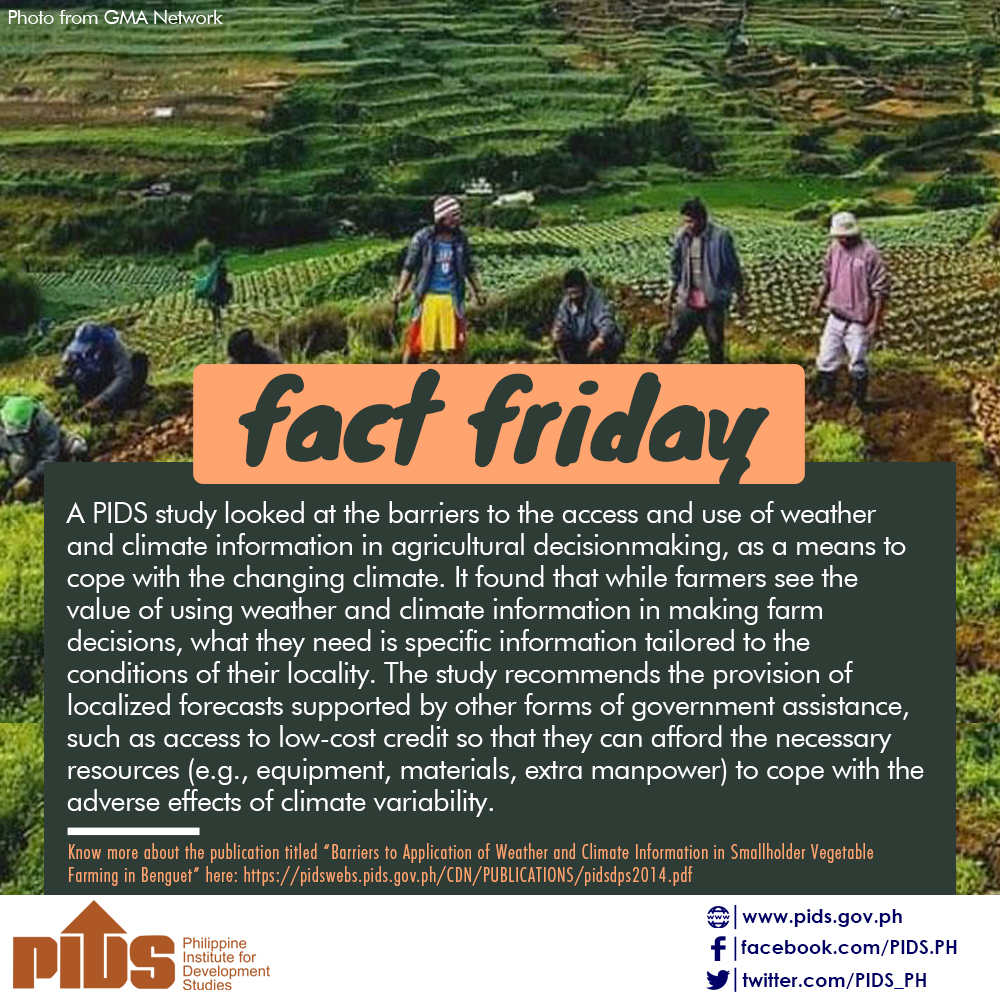A NEARLY FLAT farm output marked the first quarter, slowing from a small increment a year ago, the Philippine Statistics Authority (PSA) said on Thursday a day ahead of its gross domestic product (GDP) report for the same period, noting that increases in livestock, poultry and fisheries output narrowly offset a drop in crops that accounted for half of total value of production.
The PSA said that value of production last quarter of the farm sector — which contributes about a tenth to GDP and a fourth of jobs in the country — edged up just 0.67% annually compared to a downward-revised year-ago 1.08% increment and 1.8% in 2018’s final three months, as well as a 2.5-3.5% program under the 2017-2022 Philippine Development Plan.
Value of production of the crops subsector — the biggest contributor to total production with a 52.71% share — decreased by 1.01%, compared to a 1.1% year-ago increment.
Palay, which made the biggest contribution to total farm output value at 18.06%, dropped 4.46% in value and volume (compared to 4.61% growth a year ago) to P4.417 million metric tons (MMT) against an April 15 expectation of a 1.3% drop to 4.56 MMT.
“This was attributed to the adverse effects of the dry spell reported in Cagayan Valley, CALABARZON (Cavite-Laguna-Batangas-Rizal-Quezon), MIMAROPA (Occidental and Oriental Mindoro-Marinduque-Romblon-Palawan), Western Visayas, Central Visayas, Zamboanga Peninsula, Northern Mindanao and SOCCSKSARGEN (South Cotabato-Cotabato-Sultan Kudarat-Sarangani-General Santos City),” the PSA said.
“Bicol Region reported damage to palay production due to flooding brought by Typhoon Usman during the latter part of December 2018,” it added, citing as well reductions in area harvested and yield in Davao Region due to January floods brought by a low pressure area.
Corn, which accounted for 8.74% of total value of production, dropped 2.07% (compared to the past year’s 4.66% increase) to 2.425 MMT against an April 15 estimate of a 1.2% increase to 2.51 MMT.
“The decline was expected because of the drought which is why we are really pushing for the implementation of small and sustainable irrigation projects,” Agriculture Secretary Emmanuel F. Piñol said in a mobile phone message when sought for comment.
For Roehlano M. Briones, senior research fellow at the Philippine Institute for Development Studies, “[i]t’s pretty straight forward. I think the decline in crops is because of the impact of the El Niño.”
In a separate telephone interview, Rolando T. Dy, executive director at the University of Asia and the Pacific’s (UA&P) Center for Food and Agri-Business, said: “Drought impacted crops as expected.”
The National Disaster Risk Reduction and Management Council, which says a dry spell is characterized by three consecutive months of below-normal (21-60% reduction from average) rainfall, estimated on April 25 El Niño’s damage to rice, corn, fisheries and high-value crops at P7.96 billion, consisting of P4.04 billion (191,761 MT) in palay damage and P3.89 billion (254,766 MT) in corn damage.
Mr. Piñol had said in an April 25 social media post that “[d]espite the impact of El Niño on rice and corn production, their respective production targets can still be met as reported losses are only 0.96% (197,700 MT) of the 20 million MT target for rice and only 2.94% (254,766 MT) of the 8.64 million MT target for corn.”
All other farm subsectors gained, though slower than year-ago increments.
Livestock output, which accounted for 17.11% of total production value, grew by a slower 1.25% in terms of value (from two percent a year ago) as hog output, which accounted for 14.86% of the total, increased by 1.56% (compared to 2.39% a year ago) to 567,410 MT.
Poultry output, which contributed 16.74%, increased in value terms by 5.41% (from 5.24% a year ago) as chicken production, which accounted for 12.21%, rose 4.34% (from 4.93% previously) to 495,060 MT.
Fisheries production, which accounted for 13.45% of total farm output value, edged up by 0.97%, turning around from a 4.58% year-ago contraction, as a 3.18% drop (from -5.43% the past year) to 89,860 MT for tilapia, which contributed 1.98%, and a 4.73% contraction (from -7.38% previously) to 62,890 MT for milkfish which contributed 1.78%, were offset by a 36.16% surge (turning around from a 14.48% year-ago drop) to 53,260 MT in production of roundscad, with 0.99% of total value of production.
“Roundscad production recovered from the previous year’s slump,” the report read.
“In NCR (National Capital Region, or Metro Manila), more unloadings of roundscad were reported due to the… lifting of ban on catching roundscad in the fishing ground of Palawan and additional fishing boats from other regions” like Central Visayas, Zamboanga Peninsula and the Bangsamoro Autonomous Region in Muslim Mindanao.
This year’s first three months saw farmers get generally lower prices at the farmgate for their harvest, down 3.76% compared to a 7.64% increase a year ago. Poultry saw the biggest price drop of 8.6% from a 3.12% increase a year ago, crops came next with a 5.46% fall compared to a 6.8% year-ago rise, while livestock recorded a 1.49% contraction compared to a 13.23% increase the past year.
In its report, the PSA attributed the overall fall in crop farmgate price partly to “speculation” on lower rice prices as the government liberalized importation of the staple and replaced previous quantitative restrictions with a tariff scheme.
“‘Yung downside lang sa next semester: how will the farmer respond to the softening of palay prices,” UA&P’s Mr. Dy said.
“With the softening of palay price, ‘yun bang [will the] farmer magtatanim [plant]?”
Fishermen, however, got generally better deals, with farmgate prices rising by 6.68%, though smaller than the year-ago 9.76%.







